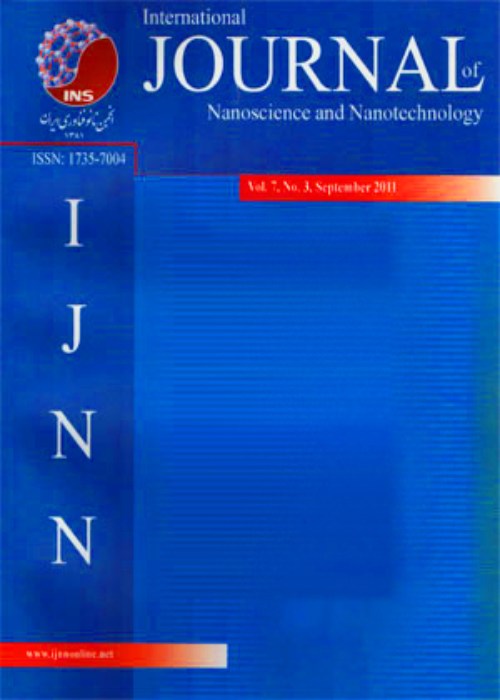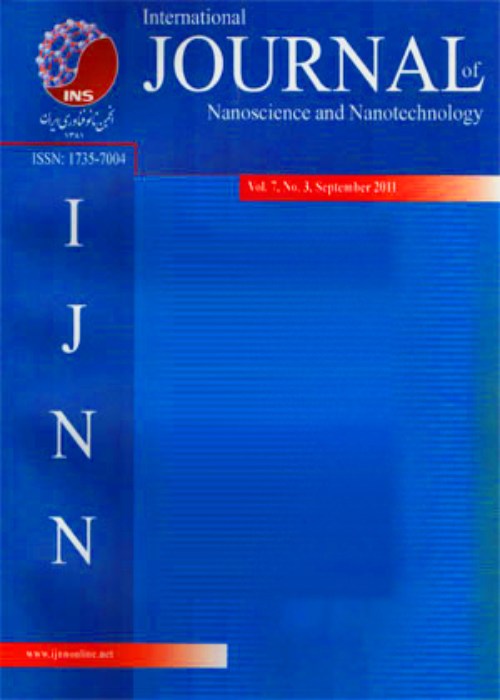فهرست مطالب

International Journal Of Nanoscience and Nanotechnology
Volume:19 Issue: 4, Autumn 2023
- تاریخ انتشار: 1402/08/10
- تعداد عناوین: 6
-
-
Pages 209-235Nanotechnology is an emerging discipline for biomedical application. Nanoparticles (NPs) research is one of the most studied and rapidly evolving field with its wide range of diagnostic and therapeutic applications, particularly in antimicrobial development. Following the improvement of the biomaterial’s functionality, the new area of ‘nanocomposites’ which often refers to the combination of NPs with other biomaterials such as hydrogel, polymers or other stabilizers, has swiftly followed. In the past decades, bacterial infections have caused negative impacts on human health, social and economic development in the globe. These problems are further aggravated by antibiotic resistance issues caused by drug-resistant microbes. With this, the development of antibacterial NPs has become an important field to alternate for the discovery of novel antibacterial agent. This review aims to discuss the key features of NPs, primarily derived from metal and metal oxide, for their antibacterial use in the clinic, the mechanisms of bacterial killing, and to cover some of the key challenges towards the Food and Drug Administration (FDA) approval for clinical use.Keywords: Drug, Antibacterial, nanoparticles, Metal, Metal oxide
-
Pages 237-248In this research paper, we looked at the synthesis and characterization of zinc nanoparticles using the green synthesis approach. The Brassicaceae family medicinal herb Lepidium meyenii Walp. was used in an attempt to make zinc nanoparticles. Zinc nanoparticles were made from zinc sulfate and an extract from Lepidium meyenii Walp. UV-VIS and FT-IR analyses were used to perform the optical characterization. The architecturally generated nanoparticles were characterized by X-RD, TEM, and SEM. The DPPH test was also used to measure antioxidant activity. At 100 μg/ml, the percentage inhibition values for ZnO-NPs, ascorbic acid, Lepidium meyenii Walp extract, and BHA were determined to be 86.62, 75.62, 71.75, and 59.35 μg/mL, respectively. The ability of the nanoparticle to prevent the growth of cancer cells in the large intestine has been found.Keywords: Antioxidant, Anticancer activity, Biosynthesis, Zinc Nanoparticles, Lepidium meyenii Walp
-
Pages 249-262The nonlinear optical properties of the InxGa1-xAs/GaAs triple quantum well structure are studied for different structure parameters and applied external electric field. Within the framework of the effective mass and envelope function approximations, the one-dimensional time-independent Schrödinger wave equation is solved using the diagonalization method to obtain the energy eigenvalues and eigenfunctions of the structure. The coefficients of nonlinear optical properties such as nonlinear optical rectification (NOR), second harmonic generation (SHG), and third harmonic generation (THG) of the structure are numerically evaluated from the corresponding expressions derived within the compact density matrix approximation. The influence of adjustable structure parameters and the applied external electric field affects the separation of subband energy levels and the magnitudes of dipole moment matrix elements. These changes in the electronic properties of the structure cause the NOR, SHG, and THG peak positions to shift towards lower or higher energy regions. It is expected that these results will enable the appropriate design of new optoelectronic devices.Keywords: InGaAs, Confinement potential, NOR, SHG, THG, Low dimensional system
-
Pages 263-275The work presents a one-step green synthesis of green luminescent C-dots using Moringa Oleifera leaves as precursor which has not been explored as a source or precursor for the fabrication of the lowest dimensional carbon material. The presence of calcium ion in the bulk structure and the surface passivated functional groups of the C-dot with a size of 1-2 nm were well correlated using extensive spectroscopic tools. The as-prepared C-dots were investigated as a fluorescent probe for detection of heavy metal ions such as Fe(III), Hg(II), Cu(II), Pb(II), Cr(VI) and As(III). The C-dots were extrapolated as a potent turn-off sensor for Cr(VI) ion in the range of 0.05-10 mM. The study provided a new approach to the application of Moringa Oleifera leaves for nanotechnology.Keywords: carbon quantum dots, Green fluorescence, Moringa oleifera, Sensing metal ions, Turn-off fluorescence, Water-soluble
-
Pages 277-293In this study, the effects of both tunable physical parameters and thermodynamic variables on the linear and nonlinear optical properties of the InGaAs/InP triple quantum well are theoretically investigated in detail. In addition, the effect of an external static electric field applied parallel to the growth direction of the structure was also studied. To carry out this analysis, firstly, the energy eigenvalues and eigenfunctions of the system were obtained as a result of solving the time-independent Schrödinger equation using the diagonalization method, under the effective mass and envelope function approach. Then, using these energy eigenvalues and eigenfunctions, the nonlinear optical properties of the structure were calculated from the expressions derived within the compact density matrix approach via the iterative method. The effect of adjustable structure parameters and applied external fields affects the difference in subband energy levels at which transitions occur and the magnitudes of the dipole moment matrix elements. These changes in the electronic properties of the structure cause the peak positions of the total (linear plus nonlinear) optical absorption coefficient and total relative refractive index change coefficient (RRIC) to shift towards lower or higher energy regions. These results are expected to enable the proper design of new optoelectronic devices.Keywords: InGaAs, InP Quantum well, Hydrostatic pressure, Temperature, external Electric field
-
Pages 295-306Developing mixed matrix membranes (MMMs) is a way to fabricate high permeation-performance membranes. The arrangement of the fillers, especially the specific-shaped ones, in the membranes has a non-negotiable influence on the gas-transport performance. With the assistance of a magnetic field, the Fe3O4 decorated attapulgite (ATP) is orderly arranged into the polymer of intrinsic microporosity (PIM-1) to form ATP/PIM-1 MMMs. Moreover, Fe3O4 decorated ATPs were coated with polydimethylsiloxane to avoid the polymeric matrix filling the cavity of ATPs. Chemical compositions of modified ATPs were determined by Fourier transform infrared spectroscopy. Morphologies of modified ATPs were observed via transmission electron microscopy and wide-angle X-ray diffraction. Morphologies of ATP/PIM-1 MMMs investigated by field-emission scanning electron microscopy. The effects of the vertically-arranged, parallelly-arranged, and disorderly-arranged ATPs on gas permeation-separation performances of ATP/PIM-1 MMMs were also reported. The parallelly-arranged ATP/PIM-1 MMMs display the best gas permeability compared with vertically-arranged and disorderly-arranged ATP/PIM-1 MMMs. And introducing the parallelly-arranged ATP brings about higher gas permeability and selectivity. Compared with the original PIM-1 membrane, the parallelly-arranged ATP/PIM-1 MMM with 5 wt.% ATP loading shows CO2 permeability of ~4018 Barrer coupled with CO2/N2 selectivity of ~19, and O2 permeability of ~672 Barrer coupled with O2/N2 selectivity of ~3. The CO2 permeability and O2 permeability increases to ~2.7 times.Keywords: air separation, CO2 separation Mixed matrix membrane, Attapulgite, Ordered arrangement


